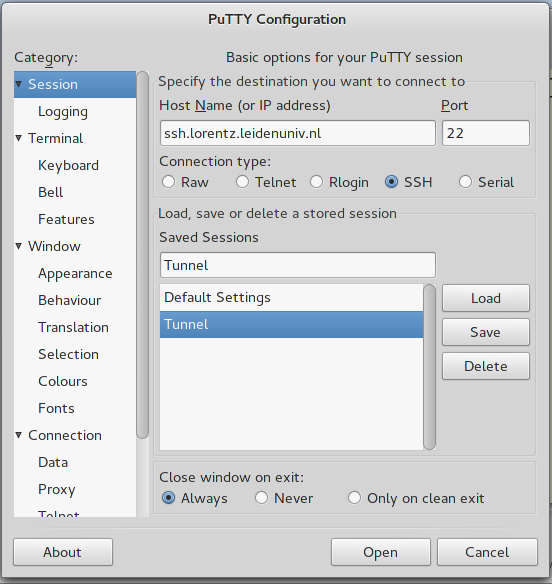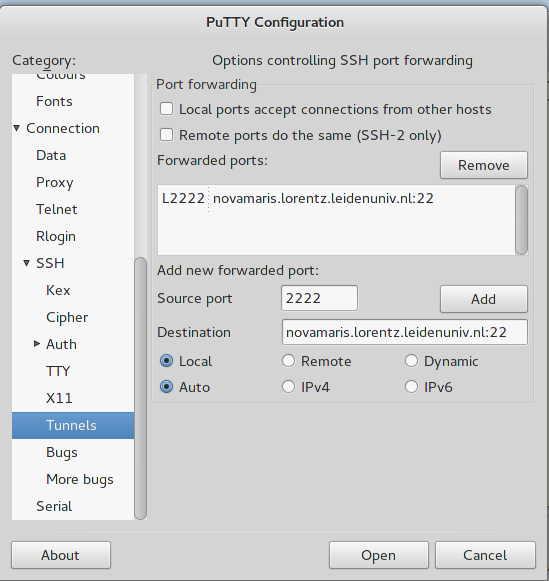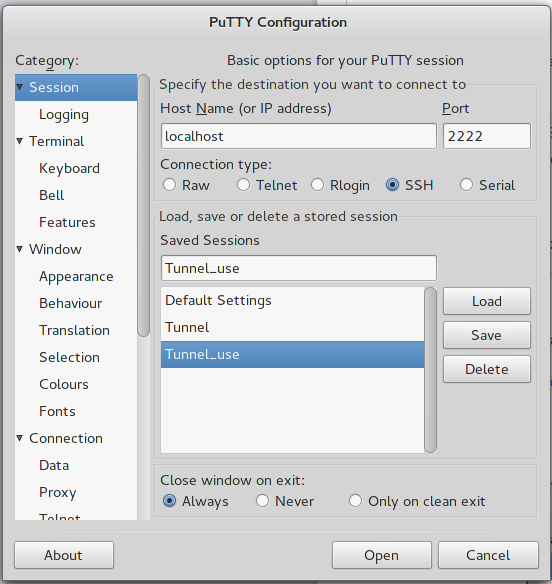This is an old revision of the document!
Table of Contents
Remote Access to your Workstation
For security reasons, access to your Lorentz workstation is only possible within the Lorentz Institute intranet. Remote access can occur either securing your connection via an intermediate step called SSH tunneling (AKA port forwarding), through the Lorentz Institute VPN service or via the Lorentz Institute Remote Workspace.
Following are some examples that demonstrate the concept of SSH tunnelling. For alternative methods of connection, please see the relevant documentation.

SSH tunneling
By means of an SSH tunnel you can transport any arbitrary data over an encrypted SSH connection. Members of the Lorentz Institute can use this technique to gain remote shell access to their workstation across our firewall which would prevent access otherwise.
How does it work?
| You must have an ssh client installed on your personal device – e.g. laptop, PC – in order to establish a tunnelled connection. |
| The Lorentz Institute has a dedicated server (SSH server) ready to listen to any (authenticated) client connections. |
| Once a client-server connection is established, a given application contacts the SSH client on a chosen port on which the client is listening. |
| The SSH client in turns forwards all encrypted application data to the server which finally communicates with the actual application server. |
For remote ssh connections to your IL workstation, the steps above can be summarised into the following. Establish an ssh client-server to our SSH server and instruct your SSH client to forward any new SSH-connection data that will be sent to an arbitrary port number to go via our SSH server. The server will then relay this information to the SSH server running on your workstation.
Example 1
Establish an SSH connection to workstation.lorentz.leidenuniv.nl via our SSH server styx.lorentz.leidenuniv.nl
ssh -o ProxyCommand="ssh -W %h:%p username@styx.lorentz.leidenuniv.nl" username@workstation.lorentz.leidenuniv.nl

-X to your SSH commands.
Example 2
As in Example 1 but this time using your client ssh configuration file usually located at $HOME/.ssh/config on GNU/Linux systems
# cat $HOME/.ssh/config
Host workstation.lorentz.leidenuniv.nl workstation
ProxyCommand /usr/bin/ssh -W %h:%p styx.lorentz.leidenuniv.nl
User username
Once this configuration is in place, a simple ssh workstation will get you to your workstation.
Example 3
Establish a web browser connection to a jupyter notebook on workstation.lorentz.leidenuniv.nl port YYYY.
Configure your local $HOME/.ssh/config as below
Host styx HostName styx.lorentz.leidenuniv.nl LocalForward YYYY localhost:YYYY Host workstation HostName workstation.lorentz.leidenuniv.nl ProxyJump styx LocalForward YYYY localhost:YYYY
Browse to http://localhost:YYYY.
Example 4
Establish a web browser connection to a Jupyter Notebook session running on node marisXX when outside the IL intranet 1)
Host lorentz
HostName ssh.lorentz.leidenuniv.nl
User username
Host maris
HostName xmaris.lorentz.leidenuniv.nl
ProxyJump lorentz
User username
Host marisXX
HostName marisXX.lorentz.leidenuniv.nl
ProxyJump maris
User username
LocalForward YYYY localhost:YYYY
Browse to http://localhost:YYYY.
Example 5: Using Putty

novamaris with xmaris.
You will need to open two putty sessions. The first one opens a tunnel, the second one uses it. For the sake of clarity let us call the first session `Tunnel' and the second one `Tunnel_use'. In this example we will establish a connection to the Maris headnode novamaris through an ssh tunnel on ssh.lorentz.leidenuniv.nl.
Session 1: Tunnel
Open putty and create a session called Tunnel, then set it according to the snapshots below
Please note the settings in the port forwarding panel. We use an arbitrary port (2222), but you can choose any numbers above 1024 provided they are not currently in use. By pushing `Open', a terminal will appear so that you can authenticate using your Lorentz institute credentials. Leave this terminal open and proceed with the creation of session `Tunnel_use'
Now push `Open' and a terminal will appear asking your authentication credentials on novamaris. Any other putty connection to localhost:2222 will ssh directly to novamaris.
VNC: GNU/Linux
For detailed instructions on how to set up a vnc session you are encouraged to follow these instructions.
Finally, take a look at x2go should you be interested.
VNC: Windows Users
Please read here.
Proxy Browsing
Read here




